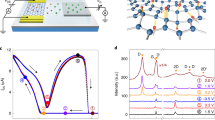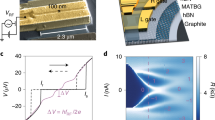Abstract
The charge-density-wave (CDW) phase is a macroscopic quantum state consisting of a periodic modulation of the electronic charge density accompanied by a periodic distortion of the atomic lattice in quasi-1D or layered 2D metallic crystals1,2,3,4. Several layered transition metal dichalcogenides, including 1T-TaSe2, 1T-TaS2 and 1T-TiSe2 exhibit unusually high transition temperatures to different CDW symmetry-reducing phases1,5,6. These transitions can be affected by the environmental conditions, film thickness and applied electric bias1. However, device applications of these intriguing systems at room temperature or their integration with other 2D materials have not been explored. Here, we demonstrate room-temperature current switching driven by a voltage-controlled phase transition between CDW states in films of 1T-TaS2 less than 10 nm thick. We exploit the transition between the nearly commensurate and the incommensurate CDW phases, which has a transition temperature of 350 K and gives an abrupt change in current accompanied by hysteresis. An integrated graphene transistor provides a voltage-tunable, matched, low-resistance load enabling precise voltage control of the circuit. The 1T-TaS2 film is capped with hexagonal boron nitride to provide protection from oxidation. The integration of these three disparate 2D materials in a way that exploits the unique properties of each yields a simple, miniaturized, voltage-controlled oscillator suitable for a variety of practical applications.
This is a preview of subscription content, access via your institution
Access options
Subscribe to this journal
Receive 12 print issues and online access
$259.00 per year
only $21.58 per issue
Buy this article
- Purchase on Springer Link
- Instant access to full article PDF
Prices may be subject to local taxes which are calculated during checkout



Similar content being viewed by others
References
Grüner, G. Density Waves in Solids (Addison-Wesley, 1994).
Rossnagel, K. On the origin of charge-density waves in select layered transition-metal dichalcogenides. J. Phys. Condens. Matter 23, 213001–213024 (2011).
Brown, S. & Grüner, G. Charge and spin density waves. Sci. Am. 270, 50–56 (1994).
Thorne, R. E. Charge-density-wave conductors. Phys. Today 49, 42–47 (1996).
Porer, M. et al. Non-thermal separation of electronic and structural orders in a persisting charge density wave. Nature Mater. 13, 857–861 (2014).
Wilson, J. A., Di Salvo, F. J. & Mahajan, S. Charge-density waves and superlattices in the metallic layered transition metal dichalcogenides. Phys. Rev. Lett. 32, 882–885 (1974).
Sipos, B. et al. From Mott state to superconductivity in 1T-TaS2 . Nature Mater. 7, 960–965 (2008).
Stojchevska, L. et al. Ultrafast switching to a stable hidden quantum state in an electronic crystal. Science 344, 177–180 (2014).
Manzke, R., Buslaps, T., Pfalzgraf, B., Skibowski, M. & Anderson, O. On the phase transitions in 1T-TaS2 . Europhys. Lett. 8, 195–200 (1989).
Yu, Y. et al. Gate-tunable phase transitions in thin flakes of 1T-TaS2 . Nature Nanotech. 10, 270–276 (2015).
Yoshida, M. et al. Controlling charge-density-wave states in nano-thick crystals of 1T-TaS2 . Sci. Rep. 4, 7302 (2014).
Joe, Y. I. et al. Emergence of charge density wave domain walls above the superconducting dome in 1T-TiSe2 . Nature Phys. 10, 421–425 (2014).
Samnakay, R. et al. Zone-folded phonons and the commensurate−incommensurate charge-density-wave transition in 1T-TaSe2 thin films. Nano Lett. 15, 2965–2973 (2015).
Hollander, M. J. et al. Electrically driven reversible insulator–metal phase transition in 1T-TaS2 . Nano Lett. 15, 1861–1866 (2015).
Xi, X. et al. Strongly enhanced charge-density-wave order in monolayer NbSe2 . Nature Nanotech. 10, 765–769 (2015).
Tsen, A. W. et al. Structure and control of charge density waves in two-dimensional 1T-TaS2 . Proc. Natl Acad. Sci. USA 112, 15054–15059 (2016).
Yoshida, M., Suzuki, R., Zhang, Y., Nakano, M. & Iwasa, Y. Memristive phase switching in two-dimensional 1T-TaS2 crystals. Sci. Adv. 1, e1500606 (2015).
Wang, L. et al. One-dimensional electrical contact to a two-dimensional material. Science 342, 614–617 (2013).
Doganov, R. A. et al. Transport properties of pristine few-layer black phosphorus by van der Waals passivation in an inert atmosphere. Nature Commun. 6, 6647 (2014).
Cao, Y.-F. et al. Transport and capacitance properties of charge density wave in few-layer 2H-TaS2 devices. Chinese Phys. Lett. 31, 077203–077206 (2014).
Rhea, R. W. Oscillator Design and Computer Simulation (McGraw-Hill, 1997).
Razavi, B. A study of phase noise in CMOS oscillator. IEEE J. Solid State Circ. 31, 331–343 (1996).
Stolyarov, M. A., Liu, G., Rumyantsev, S. L., Shur, M. & Balandin, A. A. Suppression of 1/f noise in near-ballistic h-BN-graphene-h-BN heterostructure field-effect transistors. Appl. Phys. Lett. 107, 023106 (2015).
Novoselov, K. S. et al. Electric field effect in atomically thin carbon films. Science 22, 666–669 (2004).
Lin, Y.-M. et al. Wafer-scale graphene integrated circuit. Science 332, 1294–1297 (2011).
Wu, Y. et al. High-frequency, scaled graphene transistors on diamond-like carbon. Nature 472, 74–78 (2011).
Balandin, A. A. Thermal properties of graphene and nanostructured carbon materials. Nature Mater. 10, 569–581 (2011).
Jo, I. et al. Thermal conductivity and phonon transport in suspended few-layer hexagonal boron nitride. Nano Lett. 13, 550–554 (2013).
Perfetti, L. et al. Femtosecond dynamics of electronic states in the Mott insulator 1T-TaS2 by time resolved photoelectron spectroscopy. New J. Phys. 10, 053019 (2008).
Kumar, S. et al. Local temperature redistribution and structural transition during joule-heating-driven conductance switching in VO2 . Adv. Mater. 25, 6128–6132 (2013).
Zimmers, A. et al. Role of thermal heating on the voltage induced insulator-metal transition in VO2 . Phys. Rev. Lett. 110, 056601 (2013).
Brockman, J. S. et al. Subnanosecond incubation times for electric-field-induced metallization of a correlated electron oxide. Nature Nanotech. 9, 453–458 (2014).
Horowitz, P. & Hill, W. The Art of Electronics (Cambridge Univ. Press, 1989).
Hoppensteadt, F. C. & Izhikevich, E. M. Pattern recognition via synchronization in phase-locked loop neural networks. IEEE Trans. Neural Netw. 11, 734–738 (2000).
Nikonov, D. E. et al. Coupled-oscillator associative memory array operation for pattern recognition. IEEE J. Explor. Solid State Comput. Dev. Circ. 1, 85–93 (2015).
Rahman, M. H. & Hamid, M. A. K. Solid-state oscillator using a VO2 polyconductor film as a circuit element. Int. J. Electron. 42, 65–72 (1977).
Fisher, B. Voltage oscillations in switching VO2 needles. J. Appl. Phys. 49, 5339–5341 (1978).
Lee, Y. K. et al. Metal-insulator transition-induced electrical oscillation in vanadium dioxide thin film. Appl. Phys. Lett. 92, 162903 (2008).
Leroy, J. et al. High-speed metal-insulator transition in vanadium dioxide films induced by an electrical pulsed voltage over nano-gap electrodes. Appl. Phys. Lett. 100, 213507 (2012).
Shukla, N. et al. Synchronized charge oscillations in correlated electron systems. Sci. Rep. 4, 4964 (2014).
Joushaghani, A. et al. Voltage-controlled switching and thermal effects in VO2 nano-gap junctions. Appl. Phys. Lett. 104, 221904 (2014).
Wang, Y. et al. Electrical oscillation in Pt/VO2 bilayer strips. J. Appl. Phys. 117, 064502 (2015).
Yang, Z., Ko, C. & Ramanathan, S. Oxide electronics utilizing ultrafast metal-insulator transitions. Annu. Rev. Mater. Res. 41, 337–367 (2011).
Pergament, A. et al. Vanadium dioxide: metal-insulator transition, electrical switching and oscillations. A review of state of the art and recent progress. Preprint at http://arxiv.org/abs/1601.06246 (2016).
Cavalleri, A. et al. Evidence for a structurally-driven insulator-to-metal transition in VO2: a view from the ultrafast timescale. Phys. Rev. B 70, 161102(R) (2004).
Petersen, J. C. et al. Clocking the melting transition of charge and lattice order in 1T−TaS2 with ultrafast extreme-ultraviolet angle-resolved photoemission spectroscopy. Phys. Rev. Lett. 107, 177402 (2011).
Paik, H. et al. Transport properties of ultra-thin VO2 films on (001) TiO2 grown by reactive molecular-beam epitaxy. Appl. Phys. Lett. 107, 163101 (2015).
Quackenbush, N. F. et al. Nature of the metal insulator transition in ultrathin epitaxial vanadium dioxide. Nano Lett. 13, 4857–4861 (2013).
Lieth, R. M. A. & Terhell, J. C. J. M. in Preparation and Crystal Growth of Materials With Layered Structures Vol. 1 (ed. Lieth, R. M. A.) 186 (Springer, 1977).
Acknowledgements
Nanofabrication and device testing were supported, in part, by the National Science Foundation (NSF) and Semiconductor Research Corporation (SRC) Nanoelectronic Research Initiative (NRI) for Project 2204.001 ‘Charge-Density-Wave Computational Fabric: New State Variables and Alternative Material Implementation’ (NSF ECCS-1124733) as a part of the Nanoelectronics for 2020 and beyond (NEB-2020) programme and by the Semiconductor Research Corporation (SRC) and Defense Advanced Research Project Agency (DARPA) through STARnet Center for Function Accelerated nanoMaterial Engineering (FAME). Material synthesis and device simulations were supported by the Emerging Frontiers of Research Initiative (EFRI) 2-DARE project ‘Novel Switching Phenomena in Atomic MX2 Heterostructures for Multifunctional Applications’ (NSF 005400).
Author information
Authors and Affiliations
Contributions
A.A.B. coordinated the project and contributed to the experimental data analysis; R.K.L. led the theoretical analysis; T.T.S. supervised the material synthesis and contributed to the characterization of the materials; G.L. designed, fabricated and tested the devices and analysed the experimental data; T.R.P. synthesized TaS2 crystals; B.D. conducted computer simulations. All authors contributed to writing the manuscript.
Corresponding author
Ethics declarations
Competing interests
The authors declare no competing financial interests.
Supplementary information
Supplementary information
Supplementary information (PDF 656 kb)
Rights and permissions
About this article
Cite this article
Liu, G., Debnath, B., Pope, T. et al. A charge-density-wave oscillator based on an integrated tantalum disulfide–boron nitride–graphene device operating at room temperature. Nature Nanotech 11, 845–850 (2016). https://doi.org/10.1038/nnano.2016.108
Received:
Accepted:
Published:
Issue Date:
DOI: https://doi.org/10.1038/nnano.2016.108
This article is cited by
-
Endotaxial stabilization of 2D charge density waves with long-range order
Nature Communications (2024)
-
Crystallization of polarons through charge and spin ordering transitions in 1T-TaS2
Nature Communications (2023)
-
Scanning tunneling microscopy study of hidden phases in atomically thin 1T-TaS\(_2\)
Journal of the Korean Physical Society (2023)
-
Thickness dependent charge density wave networks on thin 1T-TaS\(_2\)
Journal of the Korean Physical Society (2023)
-
Two-dimensional charge order stabilized in clean polytype heterostructures
Nature Communications (2022)



